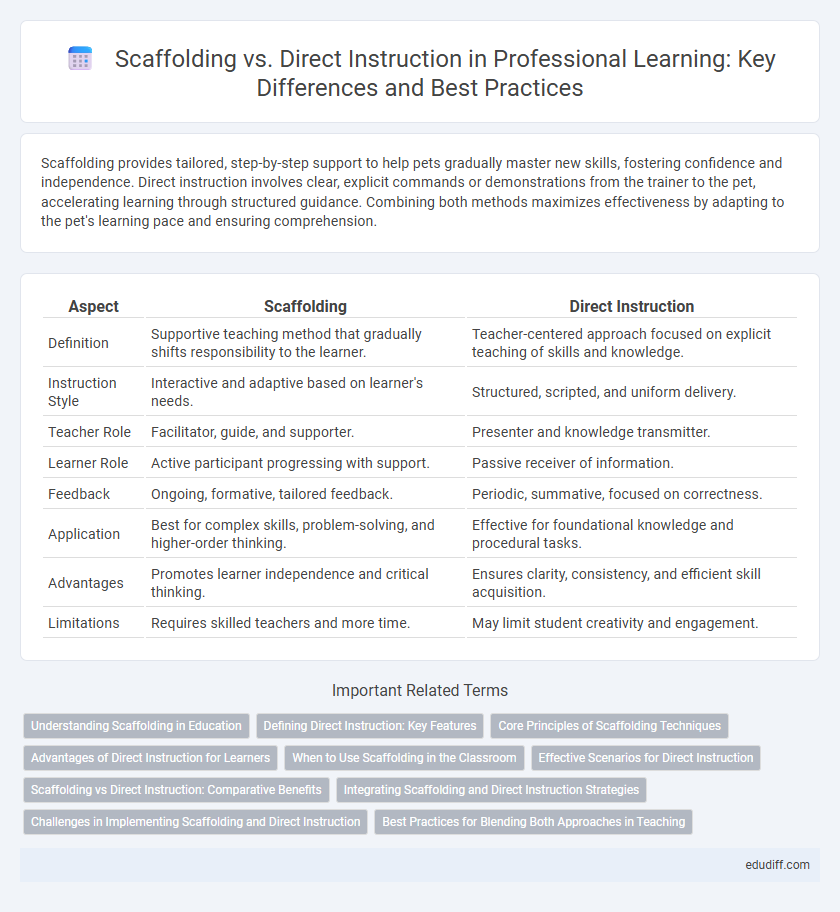Scaffolding provides tailored, step-by-step support to help pets gradually master new skills, fostering confidence and independence. Direct instruction involves clear, explicit commands or demonstrations from the trainer to the pet, accelerating learning through structured guidance. Combining both methods maximizes effectiveness by adapting to the pet's learning pace and ensuring comprehension.
Table of Comparison
| Aspect | Scaffolding | Direct Instruction |
|---|---|---|
| Definition | Supportive teaching method that gradually shifts responsibility to the learner. | Teacher-centered approach focused on explicit teaching of skills and knowledge. |
| Instruction Style | Interactive and adaptive based on learner's needs. | Structured, scripted, and uniform delivery. |
| Teacher Role | Facilitator, guide, and supporter. | Presenter and knowledge transmitter. |
| Learner Role | Active participant progressing with support. | Passive receiver of information. |
| Feedback | Ongoing, formative, tailored feedback. | Periodic, summative, focused on correctness. |
| Application | Best for complex skills, problem-solving, and higher-order thinking. | Effective for foundational knowledge and procedural tasks. |
| Advantages | Promotes learner independence and critical thinking. | Ensures clarity, consistency, and efficient skill acquisition. |
| Limitations | Requires skilled teachers and more time. | May limit student creativity and engagement. |
Understanding Scaffolding in Education
Scaffolding in education involves providing tailored support to students that is gradually removed as they develop independent skills, contrasting with direct instruction which relies on explicit teaching from the instructor. This approach leverages Vygotsky's Zone of Proximal Development by targeting tasks just beyond the learner's current ability, enhancing cognitive engagement and mastery. Effective scaffolding incorporates modeling, questioning, and feedback to foster critical thinking and autonomous problem-solving in diverse learning contexts.
Defining Direct Instruction: Key Features
Direct instruction is a structured, teacher-led approach emphasizing clear, explicit teaching of academic skills through systematic lessons and guided practice. Key features include well-defined learning objectives, step-by-step demonstrations, frequent student responses, and immediate corrective feedback to ensure mastery. This method relies on scripted lesson plans and active teacher involvement to tightly control content delivery and pacing for optimal learning outcomes.
Core Principles of Scaffolding Techniques
Scaffolding techniques in education are grounded in core principles such as providing temporary support tailored to students' current skill levels, promoting active learner engagement, and gradually transferring responsibility to foster independent problem-solving. Effective scaffolding involves diagnosing learners' needs, modeling desired behaviors or skills, and offering timely feedback to enhance comprehension and confidence. These principles contrast with direct instruction's emphasis on structured, teacher-led delivery by encouraging a more interactive, adaptive learning process.
Advantages of Direct Instruction for Learners
Direct Instruction offers clear, structured guidance that enhances learner comprehension and retention by breaking down complex concepts into manageable steps. It provides immediate feedback, allowing learners to quickly identify and correct errors, thereby reinforcing mastery of the material. This method supports efficient skill acquisition and promotes consistent academic achievement across diverse learner groups.
When to Use Scaffolding in the Classroom
Scaffolding is most effective in the classroom when students encounter new or complex concepts that require gradual skill development and support. It supports learners by breaking tasks into manageable parts, providing guidance, and gradually reducing assistance as competence increases. This approach is particularly beneficial in promoting deeper understanding and independent problem-solving in subjects like mathematics, science, and language acquisition.
Effective Scenarios for Direct Instruction
Direct instruction is most effective in scenarios requiring clear, structured learning objectives and when teaching foundational skills or introducing new concepts to novice learners. It excels in environments where precise knowledge acquisition and immediate feedback are essential, such as in language acquisition, math problem-solving, or procedural training. This method ensures consistent content delivery and supports efficient mastery of specific content standards.
Scaffolding vs Direct Instruction: Comparative Benefits
Scaffolding enhances learner autonomy by providing tailored support that gradually fades as competence increases, fostering deeper understanding and skill retention. Direct instruction offers clear, structured guidance that efficiently delivers foundational knowledge, ideal for mastering specific concepts quickly. Comparing benefits reveals scaffolding excels in promoting critical thinking and problem-solving, while direct instruction is superior for standardized content acquisition and immediate skill application.
Integrating Scaffolding and Direct Instruction Strategies
Integrating scaffolding and direct instruction strategies enhances student learning by providing structured guidance while gradually promoting independence. Tailored support through scaffolding bridges knowledge gaps as direct instruction delivers clear, explicit information essential for mastery. Combining these approaches optimizes cognitive engagement, facilitates skill acquisition, and adapts to diverse learner needs within professional educational settings.
Challenges in Implementing Scaffolding and Direct Instruction
Implementing scaffolding in professional settings often faces challenges such as adequately assessing individual learner needs and providing timely, tailored support without fostering dependency. Direct instruction encounters difficulties including maintaining learner engagement and ensuring content is neither too simplistic nor overly complex, which can hinder knowledge retention. Both methods require instructors to balance structure and flexibility while managing diverse learner profiles and varying levels of prior knowledge.
Best Practices for Blending Both Approaches in Teaching
Effective teaching integrates scaffolding and direct instruction by tailoring support to student readiness and gradually transferring responsibility for learning, ensuring mastery and independence. Employing clear, explicit explanations alongside timely, guided practice enhances comprehension and skill acquisition in complex subjects. Combining formative assessments with adaptive scaffolding strategies promotes student engagement and optimizes educational outcomes across diverse learning environments.
Scaffolding vs Direct instruction Infographic

 edudiff.com
edudiff.com